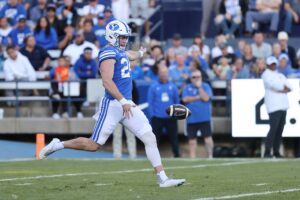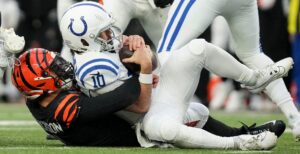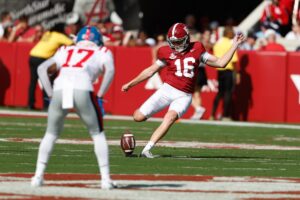Overview
Position: Tight End
Height: 6’7”
Weight: 245 pounds
School: Virginia Tech Hokies
Combine Performance Data
40-yard dash: 4.57 seconds (fifth among tight ends)
Bench press: 18 reps
Vertical jump: 39 inches (best among tight ends)
Broad jump: 11 feet, 2 inches (best among tight ends)
60-yard shuttle: 12.08 seconds (fourth among tight ends)
Bucky Hodges 2017 NFL Draft Profile
Bucky Hodges is extremely versatile, but may not have a specific position. In high school, Hodges was a starting quarterback. In fact, he was rated as a four-star recruit, and as the tenth best quarterback prospect in the country. After committing to Virginia Tech, he decided to switch positions to tight end in his first summer. That led to a redshirt freshman season where he learned the position.
In his first season as a tight end, Hodges caught 45 passes, seven of which resulted in touchdowns. He also showed versatility by rushing the ball seven times. Hodges put up almost identical numbers in his redshirt sophomore season. He caught just six touchdowns, but added a rushing touchdown. While he only had 40 catches, his yards per catch increased from 11.7 to 13.3.
As a redshirt junior, Hodges began to play even more split outside as a wide receiver. That resulted in a career high 48 catches, a career high 691 yards, and a career high 14.4 yards per catch. He added in nine rushing attempts, and showed that he is a big play threat in essentially every area of the offensive game.
With Hodges declaring for the draft, the big question will be what position will he play? Many would point to him being a tight end, but he spent a lot of his time out wide, and running routes. It will be interesting to see where teams judge him, and how they see him as a fit.
Strengths
- Ball tracking ability;
- Ability to adjust to throws in the air giving him a wide catch radius;
- Has good instincts to find soft spots in zones and sit in them;
- Has lined up wide, in the slot, inline, and as an H-back;
- Deep ball success.
Weaknesses
- Hardly was used as a blocker;
- Very raw at the tight end position given lack of experience;
- Doesn’t hold his blocks, and can get blown up off of the line;
- Struggled making physical and contested catches;
- Doesn’t have great breaks in his routes;
- Relies on his size and athletic ability over any technique.
NFL Comparison: Devin Funchess
Teams with needs at position: Miami Dolphins, Houston Texans, New York Giants, New Orleans Saints, New York Jets
Projection: third round
Bottom Line
Hodges will have to find a team that knows a specific role for him. He is too slow to consistently play on the outside. He is not sharp as a route runner, meaning he cannot live in the slot. However, he is not nearly a strong enough blocker to be used as a tight end. His play ability, size and the fact that he is so raw at playing any one position will catch the eye of some team, though.
He reminds you of Funchess in that both are not physical for their size, and contested catches should come easier to them. Hodges may be a bit better at adjusting in the air, but teams should look at Funchess, a second round pick, and realize that Hodges may not be quite worth that same equity. In the third round, his size, upside and raw ability may be a better bet to make.
Main Photo:






